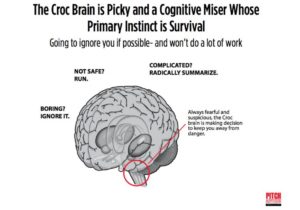Within the decision making context, you are faced with an abundance of information that is constantly fighting for your attention whilst you concurrently crusade to filter out the noise to make sense of your executional priorities. There exists an attention deficit and primal response mechanism which forms the basis of this insights series article wherein I delineate the three brains that are at the nexus of how we process and reason with information and external stimuli. The tendency for our various instincts to manufacture a perception holds strong in the subconscious. An excellent research paper titled “How The Way We Talk Can Change The Way We Work” makes it clear that “if we want deeper understanding of the prospect of change…we must pay closer attention to our own powerful inclinations to not change…”
So how do we really take this and transpose it didactically for our own benefit? We need to accept that we are hardwired biologically to firstly respond to anything with survival-first instincts. Think about a situation when you have a change management consultant telling you first up that everything you have been doing is a blatant disregard of strategic objectives? Or if you are walking to your car at night and you hear someone shouting out? Both of these situations will indeed perturb your senses!
It is therefore important to understand how we transcend these first order responses and move instinctively towards deductive reasoning. I will now delineate the bottom up mechanism that aims to bridge this disconnect between the message and receiving the message.
Basically, we all have three sections of our brain

1. The Crocodile Brain
2. The Mid-Brain
3. The Neo-Cortext
In the first instance, the crocodile brain is programmed to exhibit fight or flight type of responses. It extols strong emotions and for this reason, when it comes to decision making and deductive reasoning – it adopts a strong primitive approach with a focus on keeping us alive. Naturally, this is the first order response you will portray when meeting someone for the first time – such as that big management consultant who is coming in and telling you everything you are doing in the organisation is wrong! Therefore, its important here to understand that we, as human-beings, have a defensive mechanism that lies very much active both in the abyss and surface of our consciousness!
The mid-brain, however, will take over next and try to accept the situation socially – perhaps the big consultant is someone from a reputable company like Bain or McKinsey and Co OR that person yelling out when you were talking to your car at night is holding up something that is precious to you (you dropped your wallet whilst trying to hastily get to your car). You try to make meaning of the context and socially transposing it into relevancy. This is the archetype mid-brain at play. It is, euphemistically, diffusing the tensions and first order responses of the of crocodile brain whilst in parallel setting the directive for the Neo-Cortext to take over. Ultimately, the Neo-Cotext fine tunes the message-receiver bandwidth and scope and enables you to employ the tools of problem solving. In reference to our example, you will then understand and deduce that as the consultant is vested with ensuring your mandate is satisfied; you should in fact listen and hear out their proposition, Furthermore, you will comprehend that the person yelling out whilst you were walking to your car is in fact simply doing the right thing that is they saw you drop your wallet and wishes to return it to you. At the end of the day, honesty is our greatest facet as humans!
Whilst there are various intricacies associated with filtering, framing and deduction of information; I hope this article has made it clear that you need to drop your guard sometimes to enable the adoption of logical reasoning, common sense and higher order skills to facilitate focus and ensure no mission drift!
In a future article, I will reference this article which takes the above concepts and transplants it into a high performing team context.


